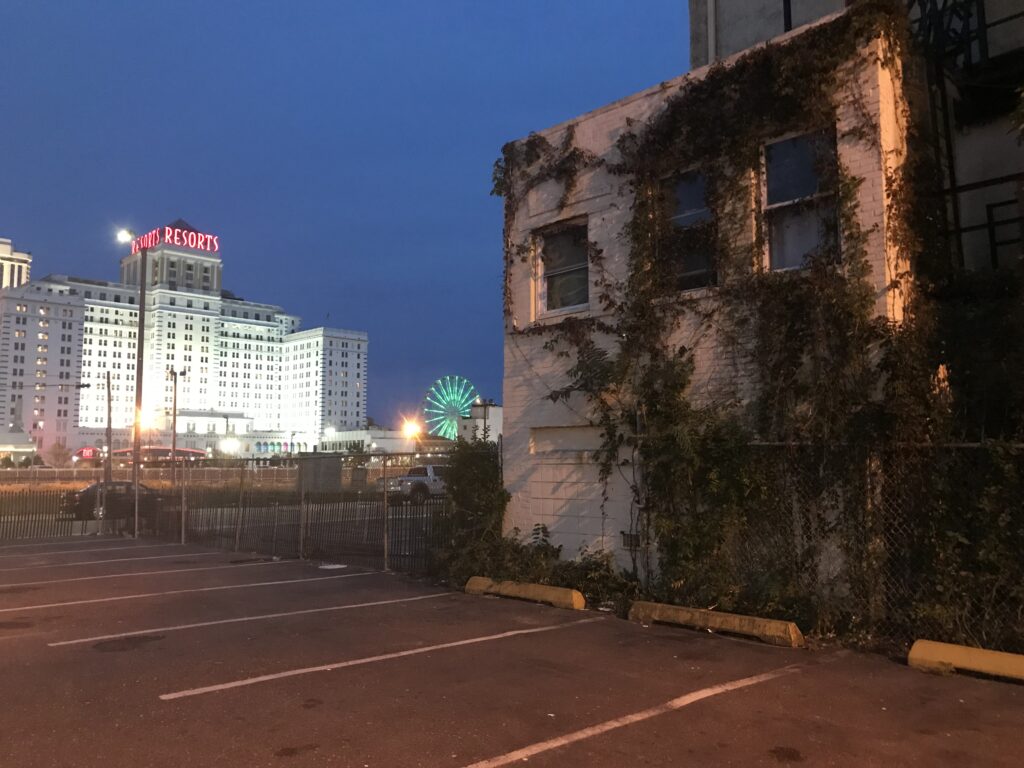CD-2 Flashpoint: Van Drew Versus Salerno

As we head down the homestretch of the 2024 election there’s been a lot of stories written like this weekend’s New York Times business section cover entitled “The Way Black Voters Have Fared in the Economy Takes Center Stage” which posits that the election “could be won or lost on the strength of the American economy” as perceived by Black voters.
There have been a spate of similar stories about Democratic Party slippage in the working class and union households more broadly. Such musings have also been served up in polling stories about Black and Latino males flirting with ‘strongman’ Donald Trump. This reporting sets off beltway corporate Democrat twitchy hand wringing followed by protestations that “this is a gangbuster economy brought to you by the most pro-union President ever—what’s wrong with these voters?!”
That’s the aggregate view from ten thousand feet up in the rarefied air high above the gritty reality of America’s Main Streets and MLK Boulevards where the American people live and die, often decades prematurely, because of the abject costly failure of the U.S. healthcare system that puts profits ahead of people. A University of California research paper published last year in Journal of the American Medical Association found that poverty had become the fourth leading cause of death in the United States.
Yet, that’s not registering as an issue.
Yes, it is true that after a half-century of flat or declining wages brought on by President Reagan’s knee capping of the American labor movement by firing all of the striking air traffic controllers, there’s been some signs of some gains for the lower strata of working families. All it took was a union revival and a mass death event that killed 1.2 million Americans, including tens of thousands of essential workers, to remind the ruling class that essential workers matter.
This income uptick in the margins for workers has to be fully contextualized amidst the unprecedented wealth concentration and corporate greedflation facilitated by generations of corrupt tax policy that both parties have their fingerprints on. What do you think the owner class has been getting all these decades for the billions they have poured into our state and federal politics?
America’s ever steeper wealth pyramid endures. Earlier this year, Fortune reported that close to one in four Americans had no savings while most surveyed didn’t have sufficient cash to cover a $1,000 emergency expense.
An August analysis by the Federal Reserve Bank of St. Louis found “the top 10% of households by wealth had $6.9 million on average” and as a group held 67 percent of the nation’s total household wealth. Meanwhile, the “bottom 50 percent of households by wealth had $51,000 on average” and as a group only had 2.5 percent of total household wealth.
And as far as the nation’s racial wealth disparity….
“Since 2010, the wealth disparity between Black and white families has persistently expanded,” reported the Brookings Institute earlier this year. “From the very first Survey of Consumer Finances in 1983, the smallest difference between Black and white family wealth was $123,910 in 1992, and has steadily climbed since, peaking in 2022.”
Brookings observed that between 2019 and 2022, “the gap breached 10 percent of the average—signaling an increase in disparity not seen since 2007, when the gap reached $214,970. The growing disparity means that in 2022, for every $100 in wealth held by white households, Black households held only $15.”
While the homestretch campaign reporting fixates on the state of the race between former President Donald Trump and Vice President Harris, it’s important to take a closer look at the battle for the House of Representatives were Republican Rep. Mike Johnson from Louisiana’s 4th CD is the Speaker by dint of just a handful of seats.
It’s instructive to notice that little “d” democracy is already on life support in Louisiana’s 4th CD where Johnson is running without any Democratic Party opposition. Talk about missing in action. Johnson’s district, which is over one third Black, is one of the most economically distressed in the nation, ranking at the top of the list of poorest districts, according to the Economic Innovation Group, a bi-partisan public policy non-profit.
EIG ranks every Congressional district for its poverty rate, high school dropout rate, vacancy rate for habitable housing, the percent of idle adults, median income, as well as local business and employment trends.
EIG reports the Louisiana’s 4th CD has a 22.1 percent poverty rate compared to the nation’s 12.6 percent. Close to a third of adults are not working as compared to close to one in five being idle nationally. Businesses are closing. Out of the 436 Congressional districts it ranks 434.
Fifty-two million Americans live in a distressed zip code.
Johnson, who currently is third in line for the succession of the Presidency, was the legislative architect of the Maga machinations that attempted to derail the certification of President Biden’s 2020 ballot box victory that led to the violent assault on the U.S. Capitol on Jan. 6. With no major party opposition, the Speaker of the House enjoys a kind of plantation primacy back home.
Johnson, along with his GOP confederates like Rep. Jeff Van Drew (R-2nd CD-NJ), voted not to certify the 2020 results AFTER the attack that contributed to the circumstances around the death of U.S. Capitol Police Officer Brian Sicknick, who grew up in South River, New Jersey.
Van Drew, who switched his party allegiance from the Democratic Party to the Republicans in 2019, specifically to swear his fealty to Trump, faces Democrat Joe Salerno. Salerno has described himself as an engineer, an attorney and entrepreneur vowing to use “his know-how in creating jobs as a businessman” on behalf of South Jersey families.
Salerno’s up beat ‘prosperity for all’ pitch echoes Vice President Harris’s uplifting opportunity for all campaign messaging.
New Jersey’s 2nd district includes the most southerly portion of the state including towns on the shore, going as far west as the Delaware River and the Jersey suburbs of Philadelphia. It includes all of Atlantic, Cape May, Cumberland and Salem counties as well as portions of Gloucester and Ocean. It includes some of the state’s poorest zip codes where Black and Latino voters have the collective power to determine the outcome of elections but of late have failed to turn out in sufficient numbers to do so.
It wasn’t that long ago that New Jersey’s 2nd CD was one of the twenty some odd Congressional districts across the country that voted for President Obama twice but then in 2016 flipped for Donald Trump. While nationally in 2016, Trump lost the popular vote to former Secretary of State Hillary Clinton, he prevailed in key swing states like Pennsylvania and Michigan to win the electoral college contest.
In 2016, it was the confluence of the 800,000 Black voters, who had voted for Obama twice, but stayed home for Clinton, and Trump’s galvanizing Reagan Democrats in union households by promoting a race based grievance that linked immigration to stagnate wages and violent crime that tipped the contest.
Van Drew was first elected in 2018 as a conservative pro-choice Democrat after veteran Republican Rep. Frank LoBiondo retired. In 2018, Van Drew, who served in the New Jersey legislature, flipped the 2nd Congressional seat for the Democrats getting 52.9 percent of the vote. He was one of only two Democrats in Congress to vote to oppose President Trump’s first impeachment and he opposed the formation of the bi-partisan commission to investigate the Jan. 6 insurrection.
In 2020, Trump was trounced by Biden in New Jersey, but Trump bested him 50.7 percent to 47 percent in the (pre-redistricted) 2nd CD where turnout in Democratic strongholds like Cumberland County’s Bridgeton and Atlantic County’s Atlantic City were really anemic, lagging by double digits behind the rest of their respective counties. In Atlantic City, just 54 percent of those registered cast a ballot, as compared to 70 percent county wide.
EIG characterizes the NJ 2nd CD as being “at risk” of becoming “distressed” using its matrix. We know from the United Way’s ALICE (Asset Limited-Income Constrained-Employed) survey that in the district’s Cumberland County 56 percent of households struggle week to week to get by.
When you add that 52 million Americans living in “distressed” zip codes, and the 62.9 million living in “at risk” zip codes, that’s 115 million, that’s more than a third of the nation.






As a former resident of South Jersey I have seen first hand why working class and poor white voters like Trump and van drew. It’s all about fear and grievance. If voters understood that Democratic policies will protect social security, the affordable health care, and make the rich pay their fair share Salerno would win easily.
Suggest you focus even more on Cumberland County which either is or will be soon a majority hispanic and African American county. Yet the Democrats have lost control of the county Commissions which they held for year.
Jeff Van Drew is sadly lacking in any core principles. His entire, bankrupt, political career has been based on following two rules: Rule #1 - Get reelected. Rule # 2 - Never forget rule # 1. Of Jeff Van Drew it can be said, "He's one of those politicians who gives opportunism a bas name."
Absolutely True, Bob Hennelly. I read the column, Kim Endorses Joe Salerno, InsiderNJ, September 9, 2024. I was unfamiliar with Joe Salerno. When I researched him, I knew he was definitely a QUALIFIED candidate. I advise other readers to do their research, also. I lost respect for Jeff Van Drew when I saw that CRINGEWORTHY spot on national TV when he pledged loyalty to Trump——ALWAYS. The residents of CD 2 deserve the BEST. To me, it is Joe Salerno, but it is their choice.